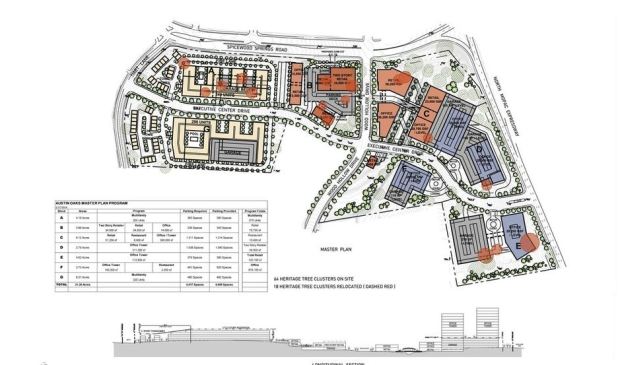Zoning commissioner voices concerns about Austin Oaks charrette
Thursday, January 7, 2016 by
Jack Craver Developers and neighbors participating in the design charrette regarding Austin Oaks, a proposed major mixed-use development at the southwest corner of MoPac Expressway and Spicewood Springs Road, told the Zoning and Platting Commission on Tuesday that preparations for the event are going well.
The charrette, which is an attempt to bring area stakeholders together to reach consensus on a project plan, will take place over five days from Jan. 25 to 29. An 18-member working group – which includes three representatives of the developer, Spire Realty Group, and 15 neighbors, some of whom are affiliated with various neighborhood associations – is overseeing the process.
After coming up with three alternative proposals for the development on the second day of the process, the participants aim to have a single proposal that will garner consensus by the end of the week. Spire Realty agreed to the charrette in October, more than a year after its original proposal for a planned unit development sparked an outcry from neighbors.
Zoning and Platting Commissioner Ann Denkler voiced several concerns based both on the description of the process given by Spire Realty and complaints she has heard from neighbors.
For one, Denkler worried that some of the charrette participants, particularly those without a strong background in planning, might not be aware of the zoning implications of the design they were selecting. While there will be presentations from city staff focused on the transportation and environmental impacts of the process, there will not be similar information presented regarding zoning, she pointed out.
“How do I know that the stakeholders present know that they’re weighing in on a plan that might be conventional zoning or PUD zoning?” Denkler asked.
While Spire Realty representatives, including President Jon Ruff and attorney Michael Whellan, noted that at least one of the three alternative plans presented at the beginning will be based on current zoning, they insisted that charrette best practices dictate that the group settle on a design before wading into discussions of zoning.
“We have continued collectively, I think, to say this is not a discussion about zoning, this is a discussion about design and how do we achieve a design that accomplished the objectives, strategies and measures for the largest number of people,” said Ruff.
Denkler said she disagreed. “To say it’s not a question of zoning – it is a question of zoning,” she said. “You have to have that (zoning) context there to know what your trade-offs are.”
Although he did not engage his colleague in debate over the issue during the hearing, Chair Gabriel Rojas indicated that he agreed with the design-first strategy in the charrette. “You show what it is that people want there and then see where it fits into our current code,” he told the Austin Monitor after the meeting.
Denkler also told the developers that they needed to make more information about the charrette available to the Zoning and Platting Commission and the public, including a list of stakeholders who either attended the event or had been invited to attend as well as a list of objectives, strategies and measures (also known as OSMs) that the charrette participants had developed.
Ben Luckens, a member of the Northwest Austin Civic Association and the charrette’s project manager, said that only a rough set of draft OSMs were available, and he criticized what he saw as hesitance from some of the commission to accept the group’s attempts to reach consensus on development.
“I wish you’d just give us a chance to do this,” he said. “Because if we showed up here with 100 raving lunatics and a phalanx of lawyers, then y’all would just sit here and say, ‘Well, that’s just the way things are.’”
Denkler told the Monitor after the meeting that because she hoped to see a successful project, she wanted to make sure that the process was transparent. If the ideas being discussed by the working group aren’t shared with the public, the charrette runs the risk of not being viewed as credible, she said. The charrette organizers, she said, could easily post updates on the process on the websites of the neighborhood associations involved.
“You won’t get consensus on the document if you aren’t transparent and you aren’t building the trust,” she said.
You're a community leader
And we’re honored you look to us for serious, in-depth news. You know a strong community needs local and dedicated watchdog reporting. We’re here for you and that won’t change. Now will you take the powerful next step and support our nonprofit news organization?








